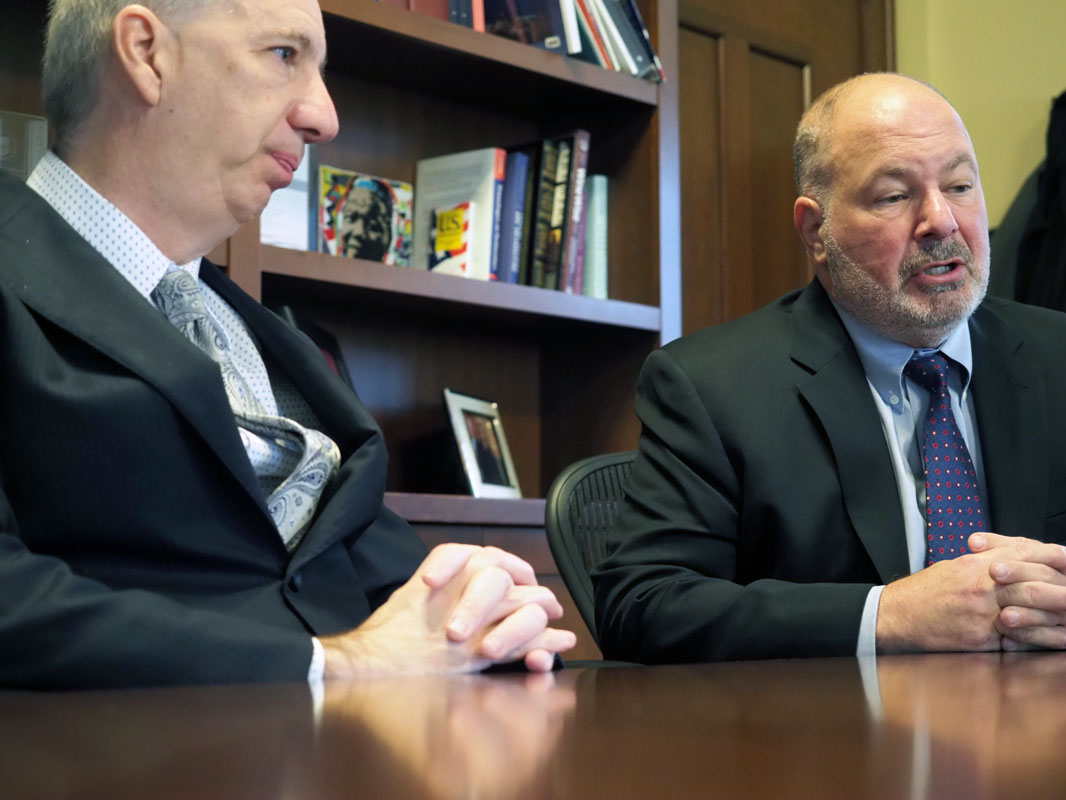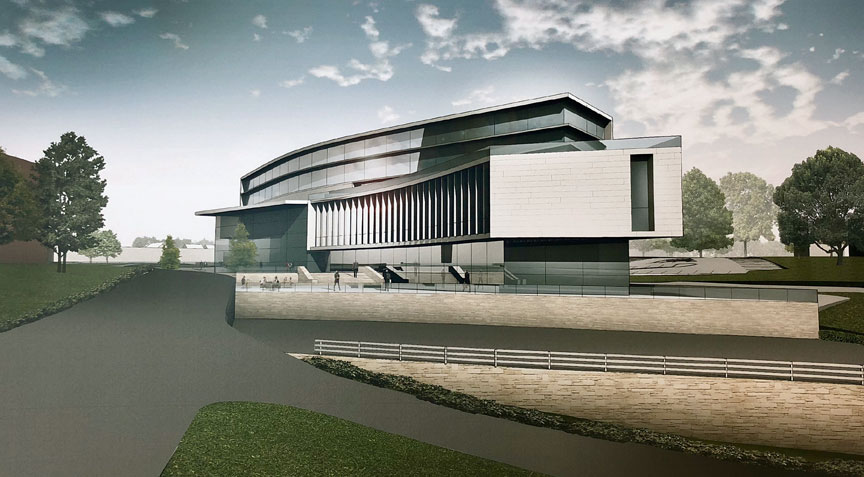Need for doctors, vision for AI innovation drive Marist, Health Quest medical school collaboration
Marist College President David Yellen was only a couple of weeks into his new job at the private Poughkeepsie school in July 2016 when he was asked to a meeting with Health Quest, the nonprofit health care system based nearby in LaGrangeville.
While it may not have been clear at the time, it was a meeting that set in motion a plan with historical implications for both institutions and education in the Hudson Valley.

“That was the first time I had any discussion about the possibility of a med school,” Yellen said of that July meeting. “It hadn”™t come up when I had interviewed for the job here, it wasn”™t in our plans. They invited us to a discussion and that got the ball rolling at that point.”
That ball rolled through a series of more meetings, research and discussions. It wasn’t until about two years later, this past September, that Health Quest officials traveled west and then up Route 9 to Marist”™s campus to announce the planned launch of the Marist Health Quest School of Medicine, with plans for a first group of students to arrive in 2022.
The total project is expected to cost $184 million, with a 100,000-square-foot academic building to be constructed on Health Quest’s Vassar Brothers Medical Center campus in Poughkeepsie. The school will be the first MD-granting institution between New York Medical College in Westchester County and Albany Medical College.
The Business Journal met recently at Marist with both Yellen and Health Quest President and CEO Robert Friedberg to discuss plans for the medical college and how the partnership came together.
For Health Quest, Friedberg said there had been conversations within the organization about the possibility of a medical school, but without any real formal plan. But both Marist and Health Quest share a trustee ”“ businessman and philanthropist Robert R. Dyson ”“ who suggested Health Quest take the idea to the college.
“It seemed possible,” Friedberg said. “We started with possible, then did all of our due diligence on whether it was actually reasonable to launch a medical school in this community, what it would take, what it would look like.”
The need
The partnership unites two growing organizations. Health Quest is already building a $545 million, 752,000-square-foot patient pavilion adjacent to Vassar Brothers hospital. The organization also plans to combine by early 2019 with Western Connecticut Health Network to form a new system that will include seven hospitals, 2,600 aligned physicians and more than 12,000 employees.

Marist, meanwhile, is nearing completion on a $26 million expansion project at the Steel Plant Studio where it hosts art programming. It has also invested $100 million in building four dormitories in recent years.
Trends in both health care and education, the two organization’s leaders said, have opened up this latest opportunity.
For every one medical college opening in universities throughout the country, there are 100 qualified applicants. That”™s a statistic important enough to the medical school’s new leadership that it is the first number you see on a “Key Facts and FAQ” web page created for the school.
There’s another statistic that Friedberg cites off the top of his head during the interview: an expected shortfall of between 40,800 and 104,900 physicians by 2030. That”™s according to data from the Association of American Medical Colleges.
Baby boomer doctors are retiring and population growth is pushing more demand, Friedberg said. Health Quest and health care providers nationwide have felt those same forces strain efforts to find physicians.
The medical college provides an opportunity, Friedberg said, “to train physicians here with the expectation and hope that they will be able to stay in this region.”
Marist Health Quest school students could fill residency programs in area hospitals, such as the one Health Quest recently launched at Vassar Brothers, and then pursue careers in the Hudson Valley and surrounding area, Health Quest officials hope.
“That”™s good for us as a health system to be able to attract that physician talent,” Friedberg said.
For Marist, which has a total undergraduate enrollment of about 5,700 plus another 1,400 graduate students, the medical college offers a chance to build significantly on health science programs recently established on campus, such as a physician assistant program and a doctoral program in physical therapy.
The new school also offers Marist a chance to to join the prestigious ranks of just 40 private colleges and universities nationwide with an MD-granting medical school. There are 151 MD-granting institutions total in the U.S. when including public institutions.
“If you look at the list of private colleges with a medical school, it is a nice group to be among,” Yellen said.
The plans
The main campus building at Vassar Brothers hospital will host the majority of school programming, but students will likely attend courses on the Marist campus as well.

The organizations won”™t exactly start from scratch in developing a curriculum. Medical colleges in the U.S. are certified by the Liaison Committee on Medical Education, which is jointly sponsored by the Association of American Medical Colleges and the American Medical Association.
To meet the criteria, Yellen said that a large majority of the curriculum must follow certain standards. But there are ways the organizations expect they can create a unique education experience. Marist and Health Quest have hired a consultant for medical schools and have just started hiring people to help form that vision.
“We have some very particular ideas about what our medical school will look like, particularly in the area of incorporating artificial intelligence,” Yellen said. “But a lot of what we will do will be a great, modern version of what all med schools do.”
So how does the new med school on the block compete with its established competitors? For Friedberg, part of the school”™s advantage will be its focus on artificial intelligence.
“That is different,” Friedberg said. “We recognize that there will be vast changes in the health care industry, just as with every other industry, in how information is used and how artificial intelligence is applied.”
But medicine is a field, he added, where changes to curriculum and physician training traditionally take time.
“We felt there was an opportunity to start a medical school based on the idea that we will develop the tools in artificial intelligence that physicians will learn to use in medical school and be able to carry into their careers,” Friedberg said.
The timeline
The first students at Marist Health Quest Medical are expected to arrive in three and a half years. Before then, there”™s work to be done.
There”™s a curriculum to organize, more than 100 full-time employee slots to fill and a campus to build. The governance of that process will be overseen by what’s been named the Marist Health Quest School of Medicine Joint Board of Overseers, split between five Marist members, five Health Quest members and Yellen and Friedberg.
The organizations are searching for the school”™s founding dean. The medical school hopes to have its LCME certification, as well as certificate from the New York State Education Department and Middle State Commission on Higher Education, by July 2021.
At capacity, the medical college expects to reach about 500 students, though Health Quest and Marist don”™t expect to hit that number until a decade after the school launches. The school’s first class will be set for just 60 students.
Between the full-time jobs, investment, student spending and the doctors the medical college brings to the region, Health Quest and Marist believe the economic impact could prove massive.
“We hope that they go from medical school to residency programs and then some portion stay here for their careers, but they are just followed by another class of medical students,” Friedberg said. “So there”™s just this perpetual influx of this group of individuals between 22 and 26 years old, and that parade just keeps going.”
“That allows us, between health care and education,” he added, “to be a vibrant catalyst for the city”™s growth.”